
Markets in Everything: Taste the Eclipse
This is the last Around the Web before Monday’s much-anticipated solar eclipse. Sky & Telescope Food & Wine has been closely monitoring the food and drink tie-ins.
We won’t cite all of Food & Wine’s “10 Eclipse-Themed Foods Along the Path of Totality,” but here are a couple:
Driftwood’s Vista Brewing is preparing a total solar eclipse wagyu burger, but the meat isn’t the only representation of the moon. Rather, the burger comes on a squid ink bun from Easy Tiger Bakery, while toppings include black garlic aioli and a wasabi pub cheese made with the brewery’s Dark Skies black pilsner.
And on the side:
“Eclipse Chipse” represent the eclipse in both rhyme and reason; Ohio-based snack brand Ballreich pairs white cheddar with black pepper for a celestial-inspired flavor. The chips come in equally thematic black bags that feature totality’s likeness.

Would like a beverage with that? Well, breweries along the path of the eclipse have been crafting eclipse-themed beers. Says Food & Wine:
In New York, more than 35 breweries have announced eclipse releases, while 13 across the path of totality have developed specialty beers in partnership with science organization the Simons Foundation.
Indiana’s Butler Hill Winery has concocted a dry “Totality” red, while Syracuse’s Emerald Cocktail Kitchen is experimenting with a charcoal gin cocktail.
Hmmm…
In Morrilton, Arkansas — which will experience totality for more than four minutes — Big Cuppa coffee shop’s eclipse menu features five themed espresso drinks.
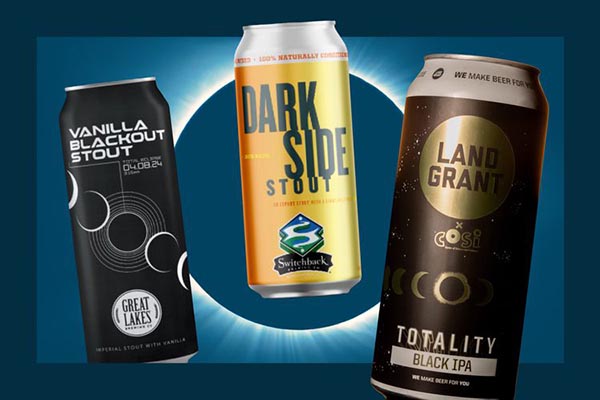
And lest we forget that Corona has been there all along.
If a diabetic coma is your cup of tea, for dessert, Krispy Kreme has partnered with Oreo to produce the “Total Solar Eclipse Doughnut.” Says Food & Wine:
According to a press release, the doughnut is made with Krispy Kreme's Original Glazed Doughnut, dipped in black chocolate icing, topped with silver sprinkles and buttercream made with Oreo pieces, and the pièce de résistance, an entire Oreo cookie in the center.
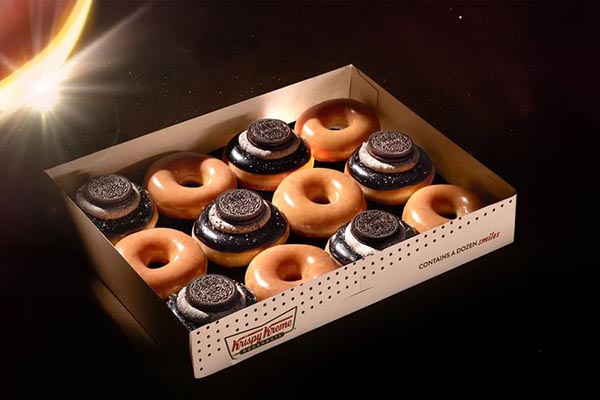
If you eat all that lot, you will blot out the sun.
And as our total coverage of eclipse mania comes to an end, enjoy, via Boing Boing, antique anthropomorphic illustrations of eclipses.
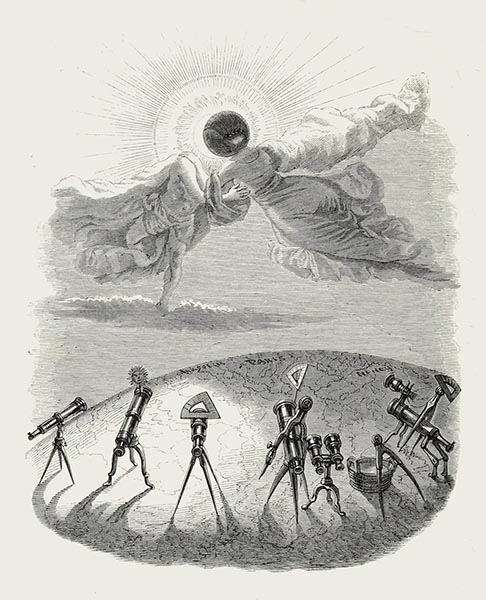
The Wales of June
If you find yourself in Cardiff, Wales, this June, be sure to check out the Printed Festival 2024, June 8–9.
Print culture in Wales is strong. The accessibility of the art-form appeals to a wide array of makers and there are many established print-related organisations in and around the Cardiff area. Canton in particular has proven itself to be a hub for print-based and print-adjacent studios. Our festival is perfectly placed in Chapter Arts Centre, bringing these businesses together for a weekend to celebrate print.
Print’s Steven Heller spoke with festival founder Aiden Saunders about it:
The first festival was funded by Laura Ashley Foundation, and as part of the activities, “We visited six different communities around Cardiff and gave free print workshops. [Now, we’ve] upped the workshops to 15 and are funded by the Arts Council Wales.”
… I teamed up with the Printhaus, an amazing print studio in the heart of Cardiff, and we started talking about the need of a print festival in Wales that can service the community. We get together and ask ourselves what in an ideal world we would like to see in a print festival, and we try our best to make it happen. Free activities, artist talks and lots of hand-printed swag. It’s a printed dream factory.

Wooden it Be Nice
Via Scientific American, a new 3D printing ink based on wood waste can recombine its components back into wooden products. And “wood waste” is a problem.
Wood is one of humanity’s oldest and most versatile building materials—but turning tree trunks into today’s plywood and two-by-fours generates huge amounts of waste. Each year the U.S. alone produces about 18 million tons of scrap wood, and more than 12 million tons of it ends up in landfills.
Off-topic, but, you know, people complain about how paper is such an environmental scourge—killing trees, ending up in landfills—but no one complains about lumber, wood flooring, wooden furniture, etc. Funny, that.
Anyway, we continue.
But researchers have now found a way to turn some of this waste into a wood “ink” that could eventually be used to 3D-print items such as furniture or architectural elements. The resulting material, described in a study published March 15 in Science Advances, looks, feels and smells like natural wood and is physically similar to work with.
Wood-based 3D printing ink is not a new thing, but it is usually made from sawdust and a binding material and create a material that doesn’t really resemble wood. The new ink, on the other hand, has been engineered to resemble wood.
To convert wood scraps into ink for 3D printing, the researchers started by combining just lignin and cellulose, keeping the ratio of these materials the same as that found in natural wood. For this part of the process, Rahman says, any kind of wood or wood waste can be used. In fact, “it does not even need to be wood,” he adds. “You can [use] any plant that has lignin and cellulose [and] deconstruct it and then mix it.”
They opted not to include synthetic materials used in current wood 3D printing, which means that the ink and whatever was printed structures could be recycled back to their constituent parts.
As a proof of concept, the researchers printed miniature furniture, letters of the alphabet and a honeycomb lattice. These structures did need some additional processing to fully maintain their shape: Air-drying deformed them, so the research team freeze-dried them at −80 degrees Celsius (-112 degrees Fahrenheit) in a vacuum. Next, they were subjected to heat treatment at 180 degrees C (356 degrees F), which caused the lignin to soften and bind better.
Structures printed this way had mechanical and thermal properties that resembled ones made from a natural hardwood: they bent and compressed in a similar way and had comparable fire resistance, Rahman explains. “Our next goal is to increase the mechanical properties further so that it can surpass the properties of hardwood,” he says. For example, certain additives could potentially make the wood more fire-resistant.
Pretty neat.
The Old Adjectival Order
Here’s one for all you copy editors out there. Did you know that there is a “royal order of adjectives”? That is, when more than one adjective is used to modify a noun, there is a more or less official order they are to be placed in. And the thing is, we kind of intuitively know the order. For example, which of the following are “wrong”?
- The black large cat demolished the furniture.
- Joseph was wearing an amazing red coat.
- The round plastic unusual object glowed in the dark.
- The incredible graphene material changed the world.
You can probably sense without knowing why that 1 and 3 are wrong, which should read “The large black cat demolished the furniture” and “The unusual round plastic object glowed in the dark.” But why? The “royal order of adjectives” specifies that order according to the type of adjective it is. Says the Cambridge Dictionary:
Adjectives which describe opinions or attitudes (e.g. amazing) usually come first, before more neutral, factual ones (e.g. red).
The order they specify is:
1: opinion (unusual, lovely, beautiful)
2: size (big, small, tall)
3: physical quality (thin, rough, untidy)
4: shape (round, square, rectangular)
5: age (young, old, youthful)
6: color (blue, red, pink)
7: origin (Dutch, Japanese, Turkish)
8: material (metal, wood, plastic)
9: type (general-purpose, four-sided, U-shaped)
10: purpose (cleaning, hammering, cooking)
And because it’s English there are of course exceptions. There are also rules about comma usage and adjectives, but we’re not going down that rabbithole.
Check it Out
Some years ago, Amazon debuted a checkout-less checkout system. Called “Just Walk Out,” customers scanned a QR code when they entered an Amazon Fresh location and they didn’t need to wait in a checkout line. (Curiously, when it opened, people would line up…to avoid waiting in a line. Huh.) Anyway, Amazon is doing away with it. Via Gizmodo:
Instead of Just Walk Out, Amazon is moving towards Dash Carts, a scanner and screen that’s embedded in your shopping cart, allowing you to checkout as you shop. These offer a more reliable solution than Just Walk Out. Amazon Fresh stores will also feature self check out counters from now on, for people who aren’t Amazon members.
Here's what struck us. While Just Walk Out sounds like a completely automated system, it actually wasn’t. They just outsourced checkout clerks:
Just Walk Out relied on more than 1,000 people in India watching and labeling videos to ensure accurate checkouts. The cashiers were simply moved off-site, and they watched you as you shopped.
Gizmodo did a follow-up article on other “automated technology” that was really just humans pretending. They start with a favorite of ours in the AtW bunker that has been written about in other places: the Mechanical Turk. It was invented in 1770 by Hungarian author and inventor Wolfgang von Kempelen (1734–1804) and was a mechanical chess-playing machine. It had a chessboard atop a large wooden cabinet, seated behind which was an intimidating mannequin which had working arms that moved the chess pieces. The Turk toured around Europe and the Americas for more than 80 years, beating nearly all of its challengers—including Benjamin Franklin. The Turk also played and beat Napoléon, although Napoléon tried to cheat repeatedly, and the Turk ended up getting annoyed and sweeping all the pieces off the board. Odd behavior for a machine...
And you can probably see where this is going: yes, hidden inside the Turk was an actual human chess master. In fact, over the years, more than half a dozen world chess masters secretly kept up The Turk’s façade as a chess-playing machine—and it was an amazingly well-kept secret.
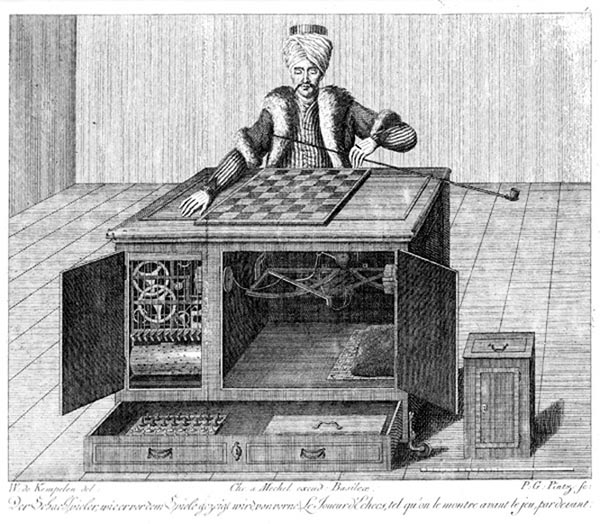
And, per the Gizmodo piece, some of the early “AI” applications were just humans pretending to be automated software.
That’s a question printers will have to start asking workflow automation system vendors: there’s not a human in there somewhere?
Why Fi?
Quick, what does the term “Wi-Fi” stand for? Surely, it’s “wireless…fidelity”? Or “wireless something” at any rate. Actually, as it turns out, it doesn’t stand for anything at all. Says Gizmodo:
The idea that Wi-Fi actually means “wireless fidelity” has been circulating on the internet since at least 2005, when Cory Doctorow of Boing Boing debunked that myth. In reality, the term was created by the marketing firm Interbrand, which also came up with the brand names for the anti-depressant Prozac and the computer company Compaq.
“The technical term was IEEE 802.11, but that just wouldn’t do,” Interbrand explains on its website. “The name had to be memorable—something universal you could find in your home, the office, a coffee shop, or on public transit and something that helped consumers intuitively understand the concept.”
So they hit on “Wi-Fi,” a pun on “Hi-Fi,” a term which itself was short for “high fidelity.”
But even though it doesn’t inherently mean anything, the branding was incredibly successful at communicating the idea that you could get wireless internet without any kind of cable, a radical idea for most Americans consumers of the 1990s who were just starting to get online in a major way.
Props to Graphene
Was it a good week for graphene news? It’s always a good week for graphene news! Graphene-coated propellers. From (who else?) Graphene-Info:
Hong Kong-based Pacific Basin, one of the world’s leading owners and operators of dry bulk ships, has decided to apply a graphene-based propeller coating, XGIT-PROP, across its entire fleet.
The biocide-free hard foul release coating, developed by Canadian company GIT Coatings, has demonstrated the potential to enhance vessel performance by up to 4%, the two companies stated in a release citing data from earlier tests carried out by Stolt Tankers.
This initiative is said to be “the largest adoption of graphene-based propeller coating in the dry bulk segment”—and who among us doesn’t keep close tabs on the dry bulk segment?
Glasses Half Full
We want. Via The Verge, Deep Optics has developed a pair of glasses containing liquid crystal lenses that can turn a pair of sunglasses into reading glasses and, presumably, vice versa. When you swipe the frame, an electrical signal is sent to the lenses to change the state of the tiny pixels that comprise them. Thus, the 32 Degrees North glasses, as they’re called, eliminate the need to carry multiple sets of spectacles.
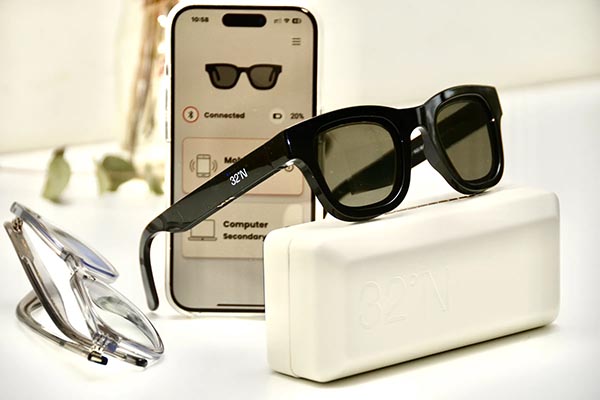
Cost: $849?!? Not with those frames. And honestly, if we’re going to lose a pair of glasses (which we inevitably do), we’d much rather it be a pair of Dollar Store readers and/or sunglasses.
Bang Goes Another Kanga
Anyone who lives in an area with a lot of deer can sympathize with a problem that is going on in Australia: animal-vehicle collisions. Down Under, it’s usually kangaroos that are hit, with, via Core 77, Volkswagen estimating that car-kanga collisions number in the “tens of thousands” every year.
To help minimize ’roo wreckage, Volkswagen is working with the University of Melbourne to develop the RooBadge, a hi-tech device for Volkswagen’s Anorak model that emits “audio deterrents” and ideally drive kangaroos off before they’re driven on.
“With multiple species of kangaroo found across Australia, all of which react differently to different sounds, producing a single sound to deter them all is nearly impossible. So, in a world-first innovation, RooBadge uses machine learning to compare its GPS coordinates against kangaroo distribution data to optimise its sound, deterring the kangaroo species that inhabit that location.”
The RooBadge isn’t always on; instead it’s geo-activated, meaning it uses GPS and telemetry. When the vehicle is traveling above a certain speed outside of a town, it kicks on. (Strangely, VW doesn't mention whether the sounds are emitted at a frequency that humans can hear; I’d think that would be a major determinant for potential buyers.)
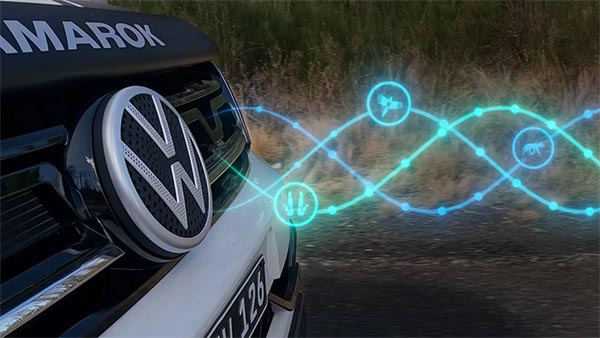
If this works, it would be great if Volkswagen could develop something similar to deter deer from gamboling in roadways. Yes, there are so-called “deer whistles” that you can attach to your car that claim to repel them, but, alas, they don’t really work:
Data currently doesn’t support the idea that deer whistles work in reducing deer-vehicle collisions. According to a study from 2003, deer whistles are unlikely to produce a sound loud enough for deer to hear at a sufficient distance to avoid traffic encounters. Also, some whistles produce sounds at a frequency that deer can’t easily hear. A 2018 review of scientific literature by Iowa State University indicates inconclusive data on the device's effectiveness but confirms they don't have any proven efficacy in preventing deer-vehicle collisions.
Tragical History Tour
A favorite holiday movie here in the AtW bunker is the 1984 Bill Forsyth film Comfort and Joy, about a Glasgow radio DJ who, after getting dumped by his girlfriend just before Christmas, gets stuck in the middle of a war between two rival ice cream truck companies. (It’s a quirky comedy, in much the same vein as Forsyth’s Local Hero, which was a sleeper hit in the US a year earlier.) Anyway, we were reminded of this when we read, on Boing Boing, about New York City’s “tour bus battle.” If you have been to NYC in recent years, you have probably seen (or even taken) one of the several “hop-on, hop-off” tour busses that cruise around Manhattan. We had no idea it was such a cutthroat business.
The combatants are Top View Buses, Gray Line and Big Bus. Dust ups and lawsuits have been going on for years. In 2018 scuffles between rival drivers and ticket sellers grew so intense that the companies drew up a conflict avoidance memo called the Conduct Guidelines.
This agreement included explicit directions to not physically assault competitors and guidance around smack talk, which was also rampant among ticket sellers. (Forbidden statements include: “They don’t have buses,” “They are being investigated by the FBI and Homeland Security,” “They don’t show you Statue of Liberty,” and “Their bus drivers are mean.”)
There was, you can imagine, a ceasefire in 2020—where there were no tourists—but it didn’t last long.
The New York State Court of Appeals has recently reinstated a claim from Top View against Big Bus and Gray Line, accusing them of operating a clandestine monopoly.
Some people refuse to take sides.
A former Big Bus tour guide seemed delighted that the companies spent so much time squabbling: “They are two miserable companies,” he tells me. “Let ’em fight it out and spend their money on lawyers.”
Maybe there could be a quirky comedy in this…
Around the Webb, Part the Ongoing: Star Treatment
We haven’t checked in with the James Webb Space Telescope in a while. What it been up to?
It recently turned its eyes to the dwarf irregular galaxy I Zwicky 18, 59 million light-years away in the constellation Ursa Major. The galaxy has been through several bursts of star formation and, says the European Space Agency, “is typical of the kinds of galaxies that inhabited the early Universe.”
Two major starburst regions are embedded in the heart of the galaxy. The wispy brown filaments surrounding the central starburst region are bubbles of gas that have been heated by stellar winds and intense ultraviolet radiation unleashed by hot, young stars. A companion galaxy lies just below the dwarf galaxy, which can be seen as the blue region at the bottom of this wide-field image. This companion may be interacting with I Zw 18’s main body and may have triggered that galaxy's recent star formation. The orange blobs surrounding the dwarf galaxy are the dim glow from ancient fully formed galaxies at much larger distances.
… Webb’s new data suggest that the dominant bursts of star formation in these regions occurred at different times. The strongest starburst activity is now believed to have happened more recently in the northwest lobe as compared to the galaxy’s southeast lobe. This is based on the relative populations of younger versus older stars found in each of the lobes.

The things we can do.
Branch Office
In this age of high-tech devices like smartphones, tablets, and wood ink 3D printers, it’s nice to see that the lowest-tech item possible is achieving a certain level of popularity: the stick. No, that’s not a new digital device—nor do we mean the Chapman Stick, the bass-like instrument that Tony Levin played on innumerable prog-rock albums—but, rather, the old-fashioned wooden stick. Via, of all places, The New York Times:
Boone Hogg, Logan Jugler and some friends were cracking jokes as they trekked toward Delicate Arch. From their free-associative silliness came the notion of reviewing a stick as you might a sculpture or valuable antique.
Later, Mr. Hogg, 30, took out his phone and shot some video of Mr. Jugler, also 30, as he mused on the qualities of a stick he had picked up from the ground. It seemed to be more interesting than the sticks nearby — it had the approximate shape of a handgun, for one thing — and Mr. Jugler found that, to his surprise, he had plenty to say about it.
And thus was born Official Stick Reviews on Instagram.
The account, which bills itself as “the internet’s go-to for stick reviews,” quickly attracted 40,000 followers, many of whom offer commentary on the sticks under discussion. They also submit photos or videos of the specimens they have come across for possible review.
There is, of course, also a TikTok, disappointingly not called StikTok, and a “Stick of the Month.”
Mr. Hogg, Mr. Jugler and their followers have come up with various metrics to judge a stick, including size, shape, color and texture. An especially large stick earned a mere 5 out of 10 rating because it “may cross the line into log territory,” one commenter said.
They could also calculate ratings using a natural log. (Sorry.) And they have also started a line of Stick Nation bumper stickers, T-shirts, and other merch.
In the more than six months since they started Official Stick Reviews, Mr. Hogg, who works in marketing, and Mr. Jugler, a physician assistant, said they have been surprised to encounter so many hobbyists who are passionate about fallen bits of branch and the like. One commenter shared that he inherited his mother’s treasured stick after she died.
“We’ve facilitated this common ground that people have,” Mr. Hogg said. “Not to be too heady about it, because it’s just sticks.”
And it stuck.
This Week in Printing, Publishing, and Media History
April 1
1854: Charles Dickens’ novel Hard Times begins serialization in his magazine Household Words.
1960: The TIROS-1 satellite transmits the first television picture from space.
1976: Apple Inc. is formed by Steve Jobs, Steve Wozniak, and Ronald Wayne in Cupertino, Calif.
2004: Google announces Gmail to the public.
April 2
1800: Ludwig van Beethoven leads the premiere of his First Symphony in Vienna.
1805: Danish novelist, short story writer, and poet Hans Christian Andersen born.
1840: French novelist, playwright, journalist Émile Zola born.
1872: American painter and academic, inventor of the telegraph and Morse code Samuel Morse dies (b. 1791).
1902: “Electric Theatre,” the first full-time movie theater in the United States, opens in Los Angeles.
1941: American radio host Dr. Demento born.
1956: As the World Turns and The Edge of Night premiere on CBS. The two soaps become the first daytime dramas to debut in the 30-minute format.
1973: Launch of the LexisNexis computerized legal research service.
April 3
1783: American short story writer, essayist, biographer, historian Washington Irving born.
1774: Irish novelist, playwright and poet Oliver Goldsmith dies (b. 1728).
1860: The first successful United States Pony Express run from St. Joseph, Mo., to Sacramento, Calif., begins.
1895: The trial in the libel case brought by Oscar Wilde begins, eventually resulting in his imprisonment on charges of homosexuality.
1898: American publisher, and co-founder of Time Magazine Henry Luce born.
1949: English singer-songwriter and guitarist Richard Thompson born.
1955: The American Civil Liberties Union announces it will defend Allen Ginsberg's book Howl against obscenity charges.
1973: Martin Cooper of Motorola makes the first handheld mobile phone call to Joel S. Engel of Bell Labs.
1981: The Osborne 1, the first successful portable computer, is unveiled at the West Coast Computer Faire in San Francisco.
2010: Apple Inc. released the first generation iPad, a tablet computer.
April 4
1581: Francis Drake is knighted for completing a circumnavigation of the world.
1768: In London, Philip Astley stages the first modern circus.
1818: The United States Congress, affirming the Second Continental Congress, adopts the flag of the United States with 13 red and white stripes and one star for each state (20 at that time).
1928: American memoirist and poet Maya Angelou born.
1975: Microsoft is founded as a partnership between Bill Gates and Paul Allen in Albuquerque, N.M.
April 5
1710: The Statute of Anne receives the royal assent establishing the Copyright law of the United Kingdom.
1908: American actress Bette Davis born.
1929: English songwriter and producer Joe Meek born.
1954: American singer-songwriter and guitarist Stan Ridgway born.
April 6
1483: Italian painter and architect Raphael born.
1861: First performance of Arthur Sullivan’s debut success, his suite of incidental music for The Tempest, leading to a career that included the famous Gilbert and Sullivan operettas.
1892: American journalist and author Lowell Thomas born.
1895: Oscar Wilde is arrested in the Cadogan Hotel, London, after losing a libel case against the Marquess of Queensberry.
1947: The first Tony Awards are presented for theatrical achievement.
1992: American science fiction writer Isaac Asimov dies (b. 1920).
April 7
1770: English poet William Wordsworth born.
1805: German composer Ludwig van Beethoven premieres his Third Symphony at the Theater an der Wien in Vienna.
1927: The first long-distance public television broadcast (from Washington, D.C., to New York City, displaying the image of Commerce Secretary Herbert Hoover).
1949: The Rodgers and Hammerstein musical South Pacific opens on Broadway; it would run for 1,925 performances and win 10 Tony Awards.
1964: IBM announces the System/360.
1969: The Internet’s symbolic birth date: Publication of RFC 1.














